
My Fossil Collection
I have many fossils in my collection, but I
have chosen my favorites to bring to you. I have also included some
information about them.
Click on each thumbnail for an enlarged
view.
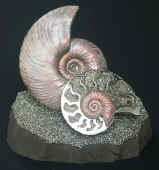 Above is an opalized, pyritized ammonoid. This species of ammonoid is called
Quenstedticeras. It is a Russian ammoniod from the Jurassic period.
It was found along the Volga River.
Above is an opalized, pyritized ammonoid. This species of ammonoid is called
Quenstedticeras. It is a Russian ammoniod from the Jurassic period.
It was found along the Volga River.
|
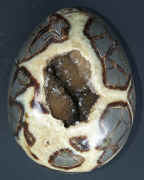
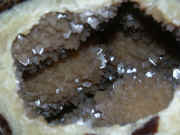 The egg above is called a Septarian.
The second view is a close-up of the internal calcite crystals. It was
formed during the Cretaceous period (50-70 m.y.a.) when the Gulf of Mexico
reached what is now Southern Utah. When sea life that was killed during
volcanic eruptions started to decompose, they were chemically attracted to the
sediment around them and formed mud balls. As the ocean receded, the balls
were left to dry and crack in the sunlight. Due to their bentonite
content, they also shrank at the same time, trapping the cracks inside. As
decomposed calcite from the shells settled down into the cracks in the mud
balls, calcite crystals formed. A thin wall of calcite was transformed
into aragonite, separating the bentonite heavy clay exteriors from the calcite
centers. Because of this, the nodules are called septarians.
The word "septarian" is derived
from the Latin name, Septem, meaning seven. This relates to the fact that
the mud balls cracked with seven points in every direction, thereby creating the
beautiful design.
Septarians are composed of calcite (the
yellow centers), aragonite (brown lines) and limestone (outer gray rock).
Occasionally, the fossil or some of the fossils which started the formation of
the rock is noticeable in the rock.
The egg above is called a Septarian.
The second view is a close-up of the internal calcite crystals. It was
formed during the Cretaceous period (50-70 m.y.a.) when the Gulf of Mexico
reached what is now Southern Utah. When sea life that was killed during
volcanic eruptions started to decompose, they were chemically attracted to the
sediment around them and formed mud balls. As the ocean receded, the balls
were left to dry and crack in the sunlight. Due to their bentonite
content, they also shrank at the same time, trapping the cracks inside. As
decomposed calcite from the shells settled down into the cracks in the mud
balls, calcite crystals formed. A thin wall of calcite was transformed
into aragonite, separating the bentonite heavy clay exteriors from the calcite
centers. Because of this, the nodules are called septarians.
The word "septarian" is derived
from the Latin name, Septem, meaning seven. This relates to the fact that
the mud balls cracked with seven points in every direction, thereby creating the
beautiful design.
Septarians are composed of calcite (the
yellow centers), aragonite (brown lines) and limestone (outer gray rock).
Occasionally, the fossil or some of the fossils which started the formation of
the rock is noticeable in the rock.
|
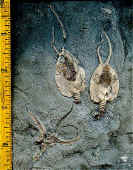
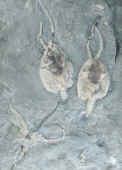 This squared off block of limestone preserves
two side by side specimens of the cystoid Pleurocystites filitextus. This
cystoid species has fine lines preserved on the plates. The specimens here
not only preserve that ornament but also three pore rhombohedrons each as well
as a long pair of tentacles. A long-armed starfish is also preserved on
the plate. It is from the Middle Ordovican, Bobcaygeon
Formation.
This squared off block of limestone preserves
two side by side specimens of the cystoid Pleurocystites filitextus. This
cystoid species has fine lines preserved on the plates. The specimens here
not only preserve that ornament but also three pore rhombohedrons each as well
as a long pair of tentacles. A long-armed starfish is also preserved on
the plate. It is from the Middle Ordovican, Bobcaygeon
Formation.
|
 This paw is from Ursus spelaeus, the extinct ice age cave
bear. It is over 11 inches long. Over 10 feet tall, this bear lived
12,000-50,000 years ago.
This paw is from Ursus spelaeus, the extinct ice age cave
bear. It is over 11 inches long. Over 10 feet tall, this bear lived
12,000-50,000 years ago.
|
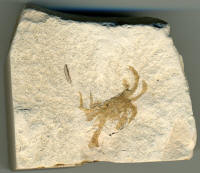 Pinnixa galliheri rathbun (type of crab)
Crab itself is approximately 3/4" wide
Monterey Formation
Aguajito Shale Member
Miocene Age
Carmel Valley, CA
Pinnixa galliheri rathbun (type of crab)
Crab itself is approximately 3/4" wide
Monterey Formation
Aguajito Shale Member
Miocene Age
Carmel Valley, CA
|
My best
fossils are in my Trilobite collection. Click here to see my Trilobite
Collection.
Go to
Collections Main Page
[
Ephemera, Nostalgia and Antiques ] [ Virtual Tom Gaskins Cypress Knee Museum ] [ Cypress Knees
and Interesting Wood ]
[ Memorabilia from
Other Cypress Knee Attractions ] [ Trilobites
] [ Rocks and Minerals ] [
Other Fossils ]
[ Frank Zappa T-Shirts ]
[
My CDs ] [ My DVDs ]
[ Tjaps ] [ Hagen-Renaker Figurines
] [ Bottles
]
[ Home ]
[ Artwork ] [
Photography ] [ Art Cars ] [
Virtual Museum ] [ Pets
] [ Favorite Links ] [
What's New / My Blog ] [
Guestbook ]
[ For Sale ]
Copyright © 2004-2024 kozmicdreams.com. All rights reserved.
All materials contained on this site, including text, graphics and icons, are the property of
kozmicdreams.com.

